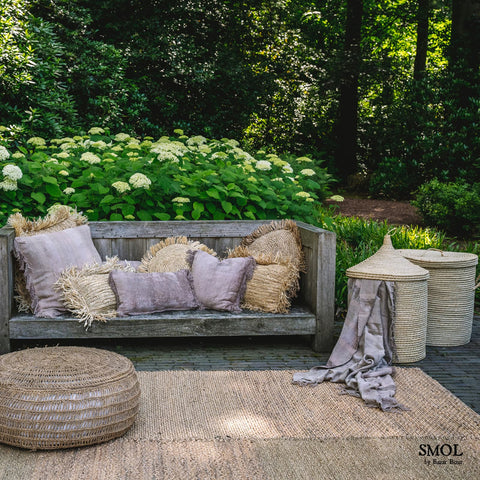How to choose a carpet?
Learn how to choose the perfect rug for YOUR home with our simple tips and style ideas.
LIVING ROOM CARPETS
This is the most visible and important rug in your home - so make it one you truly love!

TIP #1 Choose the largest rug that fits your room. A rug that is too small can disrupt the proportions of the space, and it's always cozier to have more softness under your feet.

PLACEMENT OF FURNITURE As a general rule, at least the front legs of sofas and armchairs should be on the carpet.
LEAVE EMPTY SPACE Choose a rug size that allows at least 30 cm of bare floor space around the perimeter of the room.
PLAIN OR PATTERNED Use a patterned rug to bring life to a neutral room. If your sofa or armchairs have patterned upholstery, opt for a solid color rug or a subtle pattern.
RECOMMENDED MATERIALS If your living room is a high-traffic room, choose a low-pile rug made of a durable material, such as wool or jute.
DINING RUGS
A great rug can not only soften the atmosphere but also the grandeur of a dining room.

TIP #2 Choose a rug that extends 60-75 cm beyond the edge of the table so that the dining chairs can fit on it even when pulled out.

BALANCED APPEARANCE Aim for the floor around the rug to be the same width on all sides.
KEEP IT TOGETHER For a truly unified look, aim to match the shape of the rug to the shape of the table.
COLOR IS IMPORTANT Choose colors and patterns that will help hide any stains and crumbs.
RECOMMENDED MATERIALS A high-pile rug will absorb all the crumbs deep down and can knock over chairs. Instead, choose a low-pile, large dining area rug made from a durable material, such as hand-knotted wool.
BEDROOM CARPETS
It's YOUR personal resting place, so you deserve something super soft under your feet.

TIP #3 When placed under a bed, the rug should hang at least 30 cm over the bed frame on all sides – excluding the headboard.

CENTERING Aligning the rug to the center of the bed creates a sense of balance and symmetry.
CALM Choose a soft, neutral-toned rug for a calming atmosphere.
RUNNER A runner placed on one or both sides of the bed easily creates softness under your feet.
RECOMMENDED MATERIALS In the bedroom, think softness - a dense pile blend or hand-woven rug paired with soothing, natural colors. This is the rug you wake up to every day, so it should feel warm when you look at it and step on it.
ENTRANCE, HALLWAY AND KITCHEN CARPETS
Soften these busy, functional spaces with a durable runner or small rug.
TIP #3 Leave about 15-20 cm of space between the edge of the rug and the wall or cabinet.

THINK ABOUT LENGTH Choose a rug for your kitchen that is the same length as the kitchen island for a more balanced look.
PAY ATTENTION TO THE OPENABILITY OF DOORS If you place it near a door, choose a low-pile material. It is important that the carpet allows the door to be easily opened.
MIX & MATCH Pair runners of different sizes and try mixing patterns and textures for a warm, designer look.
RECOMMENDED MATERIALS Indoor-outdoor rugs made from natural fibers are a great choice for the kitchen or hallway. They are less likely to absorb spills, making them practical around children and pets, and easy to clean.
OUTDOOR CARPETS
Define your outdoor space with a layer of indoor-style rug.

TIP #4 When choosing an outdoor rug, make sure it ends at least 20-40 cm from the edge of the patio.

CREATE A CELTIC ILLUSION A bold, striped outdoor rug can make a narrow or small space appear larger.
DEFINE THE SPACE An outdoor rug is a great way to separate your seating area from the rest of your space.
COLORS To create an outdoor oasis, it's important to use a narrow color palette that feels deliberate yet inviting.
RECOMMENDED MATERIALS The best outdoor rugs for patios and porches are made from synthetic fibers. Materials like polyester are weather-resistant and easy to clean.
CARPETS FOR SPACIOUS AREAS
When choosing rugs for spacious spaces, it's all about harmony.
TIP #5 If the room doesn't have walls, use rugs that define the space. Do this by leaving at least 60 cm between rugs.

LAYER Layer smaller rugs over larger ones to cover a larger area and create a transition between different surfaces.
PLAY WITH COLORS Keep the overall palette consistent, but don't be afraid to play with patterned and solid-colored rugs.
LAYERED APPEARANCE Layering rugs on top of each other creates a sense of dimension and flow in extra large spaces.
RECOMMENDED MATERIALS For rooms with lots of windows, rotate the rug occasionally to avoid excessive sunlight. Materials like acrylic or polyester are less likely to fade, and wool is also a good choice.
